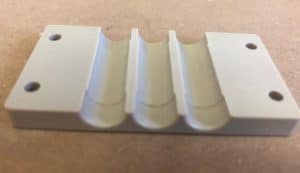
The term “plastic” covers a host of materials, from those used in kitchen utensils and plastic bags to those found in car parts and aircraft engines. Plastics are typically broken down into three categories: standard, engineering, and high performance. Standard plastics are the most common due to their low cost, but they also have the weakest mechanical properties (picture how easily a water bottle deforms). For parts that require tight tolerances and extreme conditions, high-performance plastics are a must.
Key features of high-performance plastics include high thermal stability, superior mechanical properties, and outstanding chemical resistance. These polymers are often used to replace metal because they offer comparable strength at reduced weight, greater chemical and corrosion resistance, and sliding friction characteristics. High-performance thermoplastics also have excellent electrical insulating abilities that can be used to achieve static-dissipative and electrically conductive qualities. Other benefits include great dimensional stability, excellent creep resistance for tight tolerances, and high tensile strength.
In terms of thermal stability, high-performance plastics generally have an operating temperature over 302ºF, with some well exceeding that. PEEK can hold a continuous operating temperature of 500ºF, while Celazole® PBI has a continuous service capability of 750ºF in inert environments and 650ºF in air, with short-term exposure potential up to 1,000ºF. High-performance plastics won’t deform or degrade in high-temperature applications, and maintain their superior mechanical properties.
High-performance plastics also offer great chemical resistance. PPS and PAI are resistant to a broad range of chemicals while Teflon® (PTFE) is almost entirely chemically inert and highly insoluble in most solvents or chemicals (with the exception of fluorine). Halar® (ECTFE) can resist even the harshest chemicals, acids and solvents – including sulphuric acid – without effect on its mechanical properties, and is susceptible only to hot amines and ketones.
The superior qualities of high-performance plastics (specifically their high heat resistance and strength/stiffness) can make them difficult to process, often requiring specialized machinery. This, combined with their higher material cost, generally restrict their use to specialized applications. However, their capabilities and outstanding performance make high-performance plastic parts well worth the cost.
At Reading Plastic, we specialize in high-performance parts with tight tolerances. Our experienced staff and state-of-the-art machinery allow us to machine and fabricate the precision parts you need and deliver them on time, every time. We also have the knowledge to help you choose the right high-performance plastic for your application and we can source that plastic for you, speeding up production. If you need high-quality, durable, reliable parts, call Reading Plastic today: 610-926-3245.